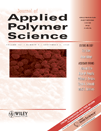Characteristics of cellulose isolated by a totally chlorine-free method from Caragana korshinskii
Abstract
The chemical composition and fiber morphology of Caragana korshinskii were investigated in this study. Isolation of cellulose was performed in a nonsulfur acetic acid/nitric acid system under various conditions. The influence of three factors, i.e., nitric acid concentration (0, 2, 4, 6, 8, or 10%), temperature (95, 100, 110, 115, 120, or 130°C), and reaction time (30, 40, 50, 60, or 90 min) on the cellulose properties (viscosity, yield, and molecular weight) was studied. The cellulose isolated was characterized by using Fourier transform infrared, gas chromatography, high performance liquid chromatography, solid-state cross-polarization magic angle spinning carbon-13 nuclear magnetic resonance, wide-angle X-ray diffraction, and thermogravimetric analysis/differential scanning calorimetry techniques. The results showed that the treatment using 80% acetic acid and nitric acid as a catalyst under the given conditions resulted in slight acetylation of the cellulose and increased the degree of crystallinity of cellulose except for significant degradation of lignin and hemicellulosic polymers. The thermal stability of the cellulose declined with an increase in nitric acid concentration. © 2006 Wiley Periodicals, Inc. J Appl Polym Sci 101: 3251–3263, 2006




